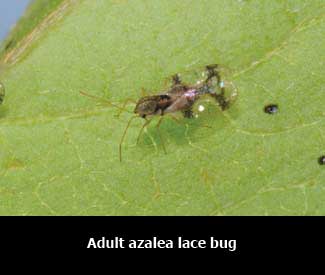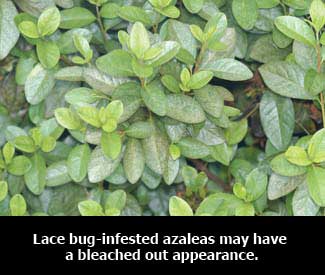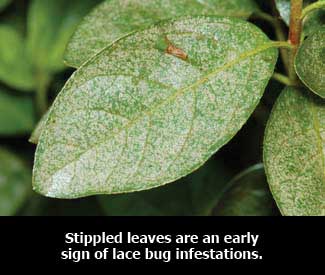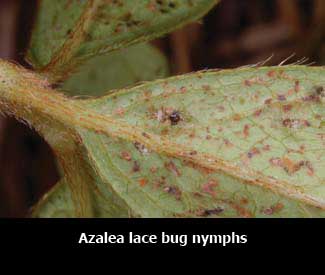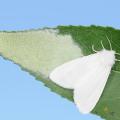Azalea Lace Bugs
Azalea lace bugs are the most common insect problem of azaleas. Adults are about 1/8 in. long with broad lacy wings, while the wingless nymphs are covered with spines. Lace bugs feed by sucking sap from the undersides of the leaves, causing affected leaves to have a stippled appearance. Infested shrubs have a bleached-out appearance which progresses to bronzing with heavy or prolonged infestations. Because lace bugs overwinter (spend the winter) as eggs inserted into plant tissue, you may not see live insects on infested plants in the winter months, but the dark fecal deposits they leave on the undersides of leaves remain as a definite sign of lace bug infestation. Azaleas growing in full sun, rather than filtered shade, are more prone to attack, and some varieties are more susceptible than others.
Control Azalea Lace Bugs: For fast-acting control of heavy lace bug infestations, spray with a foliar applied systemic insecticide such as acephate (Bonide Systemic Insect Control). For long-lasting preventive control use a soil-applied systemic treatment such as imidacloprid (Ferti-lome, Bonide, BioAdvance and others) or dinotefuran (Zylam or Safari). For best control of heavy infestations, apply a foliar spray of acephate and a soil treatment of imidacloprid or dinotefuran.
See Insect Pests of ornamental plants in the home landscape, page 17 and pages 39-41 for more information on azalea lace bugs.
Publications
News
A grant from Coast Electric will allow for a renovation of the Mississippi State University Crosby Arboretum’s pollinator garden. Pat Drackett, director of the arboretum, said the pollinator garden was established in 2001 as the Explorers’ Garden. It is a 3,000-square-foot space with a variety of native and other plants that helps teach visitors how to create havens for pollinators.
The 2020 Fall Flower & Garden Fest will be a virtual, educational event this year.
A tent for camping in the woods can be a good thing, but a tent filled with caterpillars in a pecan tree can be bad news for homeowners.

